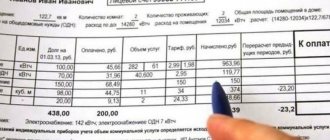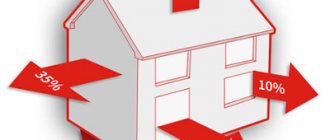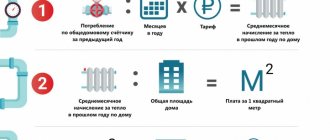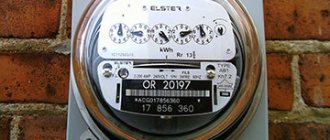How is the payment for heating in an apartment calculated? It is unlikely that most residents of apartments in high-rise buildings or owners of houses and non-residential premises connected to a centralized heating system will be able to answer this question quickly and clearly. And the problem is not that people are not interested in this issue or they “don’t understand the task”, the problem is that a very interesting situation has developed in the heat supply market, which is characterized by a very complex and cumbersome system for setting tariffs and, as a result, payments for consumers.
Considering the fact that accounting for thermal energy is associated with certain difficulties, cumbersome formulas are used for calculations, which are not always easy for even specialists to understand. But recently, there has been a tendency that consumers have become interested in this issue and are trying to figure out on their own how to calculate how much to pay for heating in an apartment or house. And this is due to the fact that the amounts in payments for consumed gigacalories are constantly growing, which significantly affects the financial situation of users who have realized the fact that they are quite capable of influencing this process themselves, and in addition, there are quite working legislative norms, significantly simplifying the task and protecting the consumer.
ORDER A SERVICE FROM ACCREDITED COMPANIES
Changes in 2019 that affected heating
When calculating heating payments in apartment buildings, some parameters have changed:
- There were two heating options, it was divided into 2 categories: individual and communal.
- We have developed special formulas for calculating those square meters and rooms that are not heated, and for residential areas with autonomous heating.
- Individual calculation of heating payments has appeared in multi-apartment buildings, which are only partially equipped with heat meters.
Also, for a more detailed calculation, new indicators were introduced that affect the amount of payment. Such as the area of common areas and the amount of Gcal of heat consumed. This value is the sum of the indicators that were taken from individual heat metering equipment or installed on the heating systems of the owners of radiator distributors.
What is Gigacalorie
A gigacalorie in heating is considered to be 1 billion calories. The last unit is calculated as the instrument required to heat 1 g of water to 1° C at normal atmospheric pressure. In 2022, for heating 1 sq. m of area requires 0.9342 Gcal for one month.
This unit has been used by the Ministry of Fuel since the mid-1990s, and has varied upwards and downwards. Taking the individual meter readings for a specific month of the year and multiplying them by the existing tariff, you get the amount payable.
How to calculate the amount yourself
You can calculate the amount of payment for heating in your apartment yourself. But before that, consider some factors:
- Determine how many months a year the payment for heat occurs. Only for the period when hot water is supplied to the batteries or throughout the calendar year.
- Find out if your apartment building has a communal heat meter installed.
- Find out whether your living space is equipped with a separate heat meter or its own radiator distributors.
- Determine how the heating system in your living space is filled with hot water. Via the central city system or through special equipment installed in your home.
Based on these parameters, you can use certain formulas to calculate payments for heating an apartment.
What are the rules for calculating payments for heat?
Be guided by the parameters that you have defined for your home and use the ready-made formula to calculate by category:
- When there is no common house heat meter (DHMU), and payments for heat supply are charged only during the months of the heating season.
- If there is no general income tax, and payments are extended over the entire calendar year.
- The house is connected to an ODPU, but separate meters are not installed in any of the premises of the building.
- The building has an ODPU installed, the apartments are partially equipped with separate devices for calculating heat energy.
If your apartment is located in a building in which ODPU are not connected, and the payment is assigned only during the heating period, the heat energy is calculated according to the standards. This is a fixed amount of energy that is required to heat 1 square meter. meters for 30 days. Standards vary depending on the region; they are adopted and approved by local leadership, taking into account climatic conditions. In this case, you can use the following formula:
P = Plz x Np x Tt
Plzh - housing area. NP - consumption standard. Тт —heat tariff.
For buildings without DPPU, in which payments are spread over 12 months, the calculation includes the coefficient of frequency of payment for utilities for heat energy. The coefficient is equal to the number of payments for the heating season divided by 12 months. And the calculation will be made according to the following formula:
P = Pl x Np x Kf x Tt
Where Kf is the calculated coefficient for monthly accounting.
Additional calculation formulas
Meters for calculating heat energy in an apartment building are installed upstream of the building. The device shows how much heat is supplied to the apartments of the entire building. Heat is calculated proportionally for all apartments. The calculation is carried out as follows:
P = (Rebt + (Plzh x (Ot - ∑Rebt)) / Plob) x Tt
Plzh is the area of the apartment. Floor area - the total area of residential and non-residential premises in a building. From - the volume of heat energy according to the ODPU readings when paid during the heating period or according to the average heat energy indicator by month for the previous year. Tt is the tariff set for heat energy. Total - the volume of heat that is needed to heat the entire living space. ∑Tot is the volume of all heat energy consumed in residential and non-residential premises of a high-rise building.
To calculate the Obt indicator, you also need a formula:
Obt = Plz x (From / (Plob - Plind + Ploi))
Ploi - the area of those premises that are for common use. Plind is the area of residential and non-residential rooms in which there are no heating devices or their own heaters are installed.
The calculation is carried out according to the following formula:
∑Obt: From/ (Plob + Ploi) x Plob
If in one residential building an individual metering device (IMU) is installed in at least one of the apartments, it is included in the calculation of the total payment for heating. To calculate payments in houses where IPU is installed in several apartments, the same formula is used as for houses with ODPU, but without IPU.
For those premises in which there is no IPU, the Obt indicator is calculated as follows:
Obt = Plzh x (∑ObtIPU / ∑PlzhIPU)
∑ObtIPU - the total amount according to the indications of the IPU, if the calculation and accrual of payment occurs during the heating season. Or by the average monthly heat volume for the previous year. ∑PlzhIPU - area of all rooms with IPU.
It’s not easy to count the first time, but even the second time, it becomes clear what indicator and what meter readings should be inserted where
Alternative options
Just as there are various ways to provide housing with heat by choosing a coolant - water or steam, there are also alternative methods for calculating the heat received. Here are two more formulas:
Thus, you can do the calculations yourself, but it is important to coordinate your actions with the calculations of the heat supply organizations. Their calculation instructions may be completely different from yours.
The calculations will be much more complicated if you plan to install heated floors in the house, but here you will need to turn on electricity. And this is a completely different “opera”, with new performers, but from the same government agencies
Helpful advice. Often reference books provide information not in the national system of units of measurement, to which calories belong, but in the international system “C”. Therefore, we advise you to remember the coefficient for converting kilocalories to kilowatts. It is equal to 850. In other words, 1 kilowatt is equal to 850 kilocalories. From here it is not difficult to convert gigacalories, given that 1 gigacalorie is a million calories.
The calculation is even more necessary when it comes to heating a country house.
All meters, and not only the simplest brownie meters, unfortunately suffer from some measurement error. This is a normal situation, unless, of course, the error exceeds all conceivable limits. To calculate the error (relative, in percent), a special formula is also used:
- V1 and V2 are the previously discussed coolant flow rates, and
- 100 – conversion factor to percentage.
The percentage of error when calculating heat is considered acceptable - no more than 2 percent, given that the error of measuring instruments is no more than 1 percent. You can, of course, make do with the old proven method; here you don’t need to do any special calculations.
This solution is sometimes life-saving and the most convenient.
What temperature should be maintained in apartments?
Heating standards in apartment buildings during the cold season:
| Room type | Optimal temperature in degrees Celsius | Permissible temperature in degrees Celsius |
| Living room | 20-22 | 18-24 |
| Living room in regions with an outside temperature of -31°C or lower | 21-23 | 20-24 |
| Kitchen | 19-21 | 18-26 |
| Corridor between apartments | 18-20 | 16-22 |
| Toilet | 19-21 | 18-26 |
| Bathroom | 24-26 | 18-26 |
| Lobby, landing | 16-18 | 14-20 |
| Pantry | 16-18 | 12-22 |
In the warm season, the norm for living rooms is optimally 22-25°C, and acceptable - 20-28°C.
If the temperature in your apartment during the heating season does not meet the established standards, you can contact the service company or utility service. They are required to investigate and obtain evidence. In this case, heating payments will be reduced. But such a solution can be called a half-measure, and it will suit few people, because the apartment will still remain uncomfortable living conditions.
Consumption standards
Each subject of the Federation has a body that determines the amount of any energy necessary for the needs of the population. Usually they are regional energy commissions. The norm is established each time for three years and is adjusted if necessary.
The table below provides information on the tariffs existing in different regions of the country:
Table 1.
| Region | Tariff (r/Gcal) |
| Moscow | 1747,47 |
| St. Petersburg | 1678,72 |
| Murmansk | 2364,77 |
| N-Novgorod | 1136,98 |
| Novosibirsk | 1262,53 |
| Khabarovsk | 1639,74 |
| Vladivostok | 2149,28 |
| Birobidzhan | 2339,74 |
However, with the beginning of the cold period of the year, the cost of a utility resource will increase by approximately 100 rubles.
How to reduce payments
To reduce the amount of monthly payments for heat, the only way is to install individual heat meters. But before that, you may encounter several problems:
- Obtaining permission to install an IPU is a time-consuming process. In order for the installation to be approved, the technical specifications must be confirmed or improved. Based on them, the appropriate type of meter is selected.
- To regularly pay for heating using an individual meter, you need to send meters for verification in a timely manner. To carry it out, the meter is dismantled and reinstalled, which entails additional costs. If the verification takes place during the heating season, then payment for heating the apartment for a time without IPU is carried out according to the established standard. Therefore, it is better to return meters in the summer, although there may be long queues at this time.
- Expensive installation of IPU. Payment for the installation of one meter can reach 25 thousand rubles. Some companies charge a separate fee for dismantling. In addition, verification is also paid. And if the meter does not pass verification by the technical service or breaks down, it must be replaced in a timely manner.
Despite the complexity and large investment during initial installation, using a custom appliance can significantly reduce your monthly heating bills.
An example of calculating the thermal loads of a commercial facility
This room is on the first floor of a 4-story building. Location: Moscow.
Initial data on the object
| Address of the object | Moscow |
| Number of floors of the building | 4 floors |
| The floor on which the premises being examined are located | first |
| Area of premises inspected | 112.9 sq.m. |
| Floor height | 3.0 m |
| Heating system | Single-pipe |
| Temperature chart | 95-70 degrees. WITH |
| Estimated temperature chart for the floor on which the room is located | 75-70 degrees. WITH |
| Bottling type | Upper |
| Estimated indoor air temperature | + 20 degrees C |
| Heating radiators, type, quantity | Cast iron radiators M-140-AO – 6 pcs. Bimetallic radiator Global (Global) – 1 pc. |
| Heating system pipe diameter | DN-25 mm |
| Heating system supply pipe length | L = 28.0 m. |
| DHW | absent |
| Ventilation | absent |
| Heat load according to the contract (hour/year) | 0.02/47.67 Gcal |
The calculated heat transfer of the installed heating radiators, taking into account all losses, was 0.007457 Gcal/hour.
The maximum heat energy consumption for heating the room was 0.001501 Gcal/hour.
The final maximum flow rate is 0.008958 Gcal/hour or 23 Gcal/year.
As a result, we calculate the annual savings for heating this room: 47.67-23 = 24.67 Gcal/year. This way you can cut your heating energy costs by almost half. And if we take into account that the current average cost of Gcal in Moscow is 1.7 thousand rubles, then the annual savings in monetary equivalent will be 42 thousand rubles.
The essence of the work of the IPU
An individual meter, which is connected to the heating system, takes into account heat energy consumption in the form of calculating the difference between the temperature achieved in the room and the coolant flow rate. Before installing IPU in your apartment, determine which heating system wiring in your high-rise building is vertical or horizontal.
The meters are attached directly to the heat supply pipe. If you have a vertical distribution system in a high-rise building, you will have to install one metering device for each pipe, and this is a very expensive undertaking. Each room will require a separate meter. There is no such problem with a horizontal system; only one device is enough. If the heating system is a riser system, distributors can be installed on the radiators. They calculate coolant flow by calculating the temperature difference in the room and from the surface of the radiator.
As a rule, high-rise buildings built after 2000 have a horizontal heating system. Therefore, it will be cheaper to install an IPU in a new building than in Soviet-built apartments. After installing the meter, the craftsmen seal it to prevent fraudulent activities on the part of residents or tenants.
Find out also how to save on electricity and pay utilities without commission.
5 / 5 ( 2 voices)
about the author
Klavdiya Treskova - higher education with qualification “Economist”, with specializations “Economics and Management” and “Computer Technologies” at PSU. She worked in a bank in positions from operator to acting. Head of the Department for servicing private and corporate clients. Every year she successfully passed certifications, education and training in banking services. Total work experience in the bank is more than 15 years. [email protected]
Is this article useful? Not really
Help us find out how much this article helped you. If something is missing or the information is not accurate, please report it below in the comments or write to us by email
Help from specialists
If at this moment it is suddenly unclear to you how to install heating in an apartment, then for this you need to contact qualified specialists. They will tell you everything and recommend how to choose the optimal parameters. First, a project is carried out, which shows an approximate layout of the heating system in the room.
After all the nuances have been clarified and approved, you can purchase equipment and ask about additional heating solutions in the house. The main thing is not to allow initiative in this matter, otherwise the system may break down and flood the neighbors, who are unlikely to be grateful to you for such a gift.
Comments: 11
Your comment (question) If you have questions about this article, you can tell us. Our team consists of only experienced experts and specialists with specialized education. We will try to help you in this topic:
Author of the article: Klavdiya Treskova
Consultant, author Popovich Anna
Financial author Olga Pikhotskaya
- Sergey
02/12/2022 at 22:29 Good afternoon! The heating company sent a notice. You are given the opportunity to pay in installments in equal installments over a period of 12 months. with interest charged for installments in the amount of the refinancing rate of the Central Bank of the Russian Federation. How legal is it to charge interest on installment payments in this case?
Reply ↓ Anna Popovich
02/14/2022 at 19:00Dear Sergey, this is legal and corresponds to the calculation of the amount due, taking into account the payment in installments.
Reply ↓
02/10/2022 at 23:44
Good afternoon. During two heating periods, the management organization in the payment document provides readings for the heating ODPU equal to the total reading of the consumers' IPU. The volume Vodn is equal to zero. The apartment building is equipped with a heat control unit and a heat control unit in each room. GZHI, UO, when I demand you give me detailed heating calculations, they don’t give me. I sent an appeal to the Regional Prosecutor's Office and they returned it to the State Housing Inspectorate. Help me decipher how they prove they are right or I’m a fool. The second question is what area is taken when calculating heating fees - the total residential and non-residential or the total area of the building. I think the area of the veins is taken. and non-residential premises plus the area of places included in the common property results in the area of the building. Thank you for your help.
Reply ↓
02/09/2022 at 22:28
Hello, there is a calculation for heating for 2022, but it seems to me that everything is wrong, the Criminal Code says they calculated it using formulas, can you check the calculation? The problem is that we pay according to the IPU, there is a common meter at home, but every January an adjustment comes for last year, this year + 14 thousand. That year +7 thousand.
Reply ↓
02/08/2022 at 15:38
We have an apartment in an apartment building and we usually paid by receipts only during the heating period, but then a friend told me that it is possible to determine the order of payments throughout the year, how to do this and how profitable is it?
Reply ↓
- Anna Popovich
02/09/2022 at 01:06
Dear Alena, you need to contact the management company. Paying for heat throughout the year is considered economical, since such calculations reduce the financial burden on the consumer.
Reply ↓
01/22/2022 at 22:45
In an apartment building, an OPU PO 261-FZ was installed, last summer the device was taken out of service (the reasons are not given, the device is broken), but we are still paying in installments for the installation and maintenance of a non-working device. Question: -Should we pay for this non-working device? -How should you pay for heating in this case?
Reply ↓
12/22/2021 at 12:45
Hello dear experts. Please answer, does the heating supplier have the right to charge payment according to the standard 2 weeks before the start and 2 weeks after the end of the 8-month heating season if a common building heat meter is installed? It turns out that we pay for 8 months according to the meter and the ninth month according to the standard, with the exception of 3 months of summer. Thank you for your answer.
Reply ↓
11/22/2021 at 10:08 am
If an apartment building receives coolant from the boiler room, but an additional boiler is installed in the house, how does this affect the amount of payment for heat? Is it possible to somehow control the accuracy of the calculations?
Reply ↓
- Anna Popovich
25.11.2021 at 19:18
Dear Irina, when preparing hot water using the in-house engineering systems of an apartment building (in the absence of a centralized preparation of hot water), the amount of payment for hot water supply is calculated based on meter readings and the corresponding tariffs for cold water and fuel used to prepare hot water. At the same time, the costs of maintaining and repairing in-house engineering systems used for preparing hot water are included in the fee for maintaining and repairing residential premises.
Reply ↓
09.13.2021 at 12:59
The house has a common heating supply meter. There is no countdown counter! how the heat consumption should be calculated.
Reply ↓











